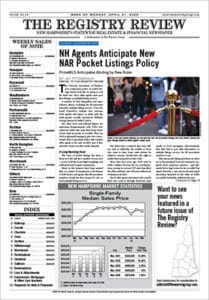
Despite the surge in multifamily construction in many parts of the state, rents have increased to the point that almost one in two middle-class renters are paying unaffordably high rent.
In New Hampshire and across the country, middle-class renters are being squeezed by changes in the state’s rental housing market, according to a new report from Harvard University.
The study by the Joint Center for Housing Studies found 40 percent of Granite State households earning between $30,000 and $45,000 per year now paying more than 30 percent of their pretax income in rent, the maximum generally considered affordable.
Twenty-three percent of the state’s renters making between $45,000 and $75,000 find themselves in the same boat. At the same time, only 2.5 percent of households making more than $75,000 share the predicament.
Statewide, while the overall share of renters in this category went down slightly since 2008, the share of renters paying over half their income for housing increased, from 19 percent to 23 percent.
“Despite the strong economy, the number and share of renters burdened by housing costs rose last year after a couple of years of modest improvement,” the center’s managing director Chris Herbert said in a statement. “And while the poorest households are most likely to face this challenge, renters earning decent incomes have driven this recent deterioration in affordability.”
The crunch is worst in and around Keene and Laconia, where the report found 52 percent of the Keene area’s 10,000-plus renters and 51 percent of Laconia’s 6,000-some renters are paying over 30 percent of their income in rent. In Manchester and Nashua, where the median renter income is $41,050 and median rent is $1,132, 49 percent of the area’s roughly 55,000 renters are paying unaffordable rents.
New Supply Focused on High End
With higher-income households accounting for much of the growth in rental demand since 2010, new supply has been concentrated at the upper end of the market, the report found. Meanwhile, rising demand and constricted supply have reduced the stock of low- and moderate-cost rental units, leaving modest-income renters caught in the middle.
Like much of the country, investors and tenants alike have flocked to rental housing. New Hampshire gained around 15,000 renter households between 2008 and 2018, an 11 percent increase. About 155,000 families, or 29 percent, out of the state’s 531,212 now rent. That’s up from 26 percent of the state’s households in 2008.
The study found New Hampshire added 15,900 rental units from 2008 to 2018, largely in buildings with 20 or more units – 10,400 units in these buildings were added over the time period, along with 5,400 single-family rental homes.
The rent in the state’s 166,596 units is concentrated above $1,000 per month – 45 percent of the state’s units hit or exceed this mark, the report found, with nearly 20 percent priced at $1,400 per month and above.
Further constraining the market, renting has become more common among those traditionally more likely to own their home, including those aged 35-64, older adults, and married couples with children. Indeed, families with children now make up a larger share of renter households across America (29 percent) than owner households (26 percent).
“Rising rents are making it increasingly difficult for households to save for a downpayment and become homeowners,” Whitney Airgood-Obrycki, lead author of the report, said in a statement. “Young, college-educated households with high incomes are really driving current rental demand.”
It’s a trend most evident in southeastern New Hampshire, as booming white-collar industries in Manchester, Portsmouth and Nashua stimulate demand for higher-end housing. The same demand and the increasing rents it generates have driven up prices for multifamily properties, particularly in the Manchester area, with several large complexes there selling for over $30 million in the last year.
Increasingly, local governments have found themselves on the front lines of the rental affordability crisis. In response, Gov. Chris Sununu and a bipartisan group of legislators recently proposed a plan that would set deadlines for towns and cities to make decisions on projects, and take other steps to liberalize land use policies.
“Last year, Minneapolis became the first large American city to end single-family zoning,” Herbert said. “This has the potential to greatly expand the rental supply and improve affordability in that city but, ultimately, only the federal government has the scope and resources to provide housing assistance at a scale appropriate to need across the country.”

